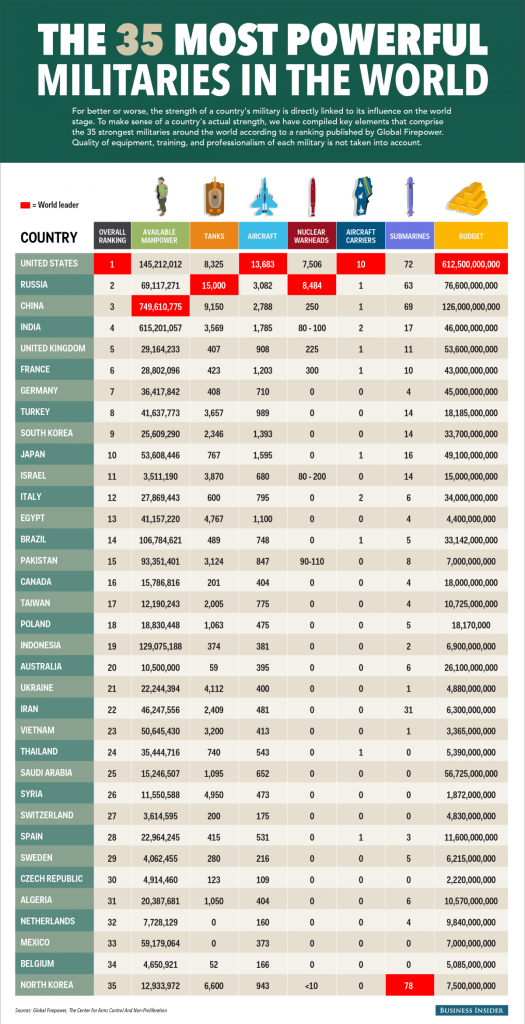The 35 Most Powerful Militaries in the World
MILITARISM, 14 Jul 2014
Amanda Macias, Jeremy Bender and Skye Gould – Business Insider
There’s only one true way to compare military strength, and thankfully we haven’t had the opportunity to compare powerful countries in recent decades — though with a powder keg in the South China Sea, standoffs in Ukraine, and proxy wars throughout the Middle East, we are alarmingly close.
For a simpler evaluation of military power, we turn to the Global Firepower Index, a ranking of 106 nations based on more than 50 factors including overall military budget, available manpower, and the amount of equipment each country has in its respective arsenal, as well as access to resources.
The index focuses on quantity, ignoring significant quantitative differences (North Korea’s 78 submarines, for instance, aren’t exactly state of the art). It also does not factor in nuclear stockpiles — still the ultimate trump card in geopolitics. It also does not penalize landlocked nations for lack of a standing navy.
We’ve created a chart to compare the top 35 militaries according to the Global Firepower Index. The ranking, released in April, involves a complex set of data that is subject to ongoing adjustments and corrections.
Here Are The Key Findings From The Index:
America’s investment in being the world’s police force.
The U.S. clearly leads the world in military spending at more than $600 billion. China is the closest nation to follow the US at nearly $130 billion — still less than one-third of America’s overall spending.
According to a report from the Stockholm International Peace Research Institute (SIPRI), the U.S. has reduced its defense budget by 7.8% chiefly because of America’s gradual withdrawal in overseas military operations, such as in Afghanistan and Iraq.
Russia has increased its arms spending by $88 billion and plans to “modernize” its weapons arsenal.
The role of aircraft carriers.
Aircraft carriers contribute greatly to a country’s overall military strength. These massive vessels allow nations to project their force far beyond their borders and across the entire face of the globe by functioning as essentially a mobile naval and air force base. Aircraft carriers can also carry drones, which significantly change the global surveillance game.
The U.S.’s absolute monopoly on these vessels significantly boosts the country’s forward operating power. The U.S. has deployed an aircraft carrier toward the Persian Gulf to bolster its sea and air power before possible strikes against ISIS in Iraq. Russia has previously deployed an aircraft carrier to the Mediterranean to display its seriousness in propping up Assad in Syria.
North Korea’s submarines.
An anomaly in the Global Firepower index is North Korea’s ranking as a world leader for submarines. North Korea’s submarine lead is due to the fact that the country, in terms of pure numbers, has more submarines than any country in the world.
But these submarines are almost entirely unusable. A third of North Korea’s subs are noisy diesel-powered Romeos, which have been obsolete since 1961. These submarines have a weapons range of only four miles, whereas a modern U.S. submarine has a weapons range of 150 miles. By and large, this fleet is unsophisticated but durable, according to the U.S. Department of Defense.
See Also: MAP: All 17,000 Of The World’s Nukes
Go to Original – businessinsider.com
DISCLAIMER: The statements, views and opinions expressed in pieces republished here are solely those of the authors and do not necessarily represent those of TMS. In accordance with title 17 U.S.C. section 107, this material is distributed without profit to those who have expressed a prior interest in receiving the included information for research and educational purposes. TMS has no affiliation whatsoever with the originator of this article nor is TMS endorsed or sponsored by the originator. “GO TO ORIGINAL” links are provided as a convenience to our readers and allow for verification of authenticity. However, as originating pages are often updated by their originating host sites, the versions posted may not match the versions our readers view when clicking the “GO TO ORIGINAL” links. This site contains copyrighted material the use of which has not always been specifically authorized by the copyright owner. We are making such material available in our efforts to advance understanding of environmental, political, human rights, economic, democracy, scientific, and social justice issues, etc. We believe this constitutes a ‘fair use’ of any such copyrighted material as provided for in section 107 of the US Copyright Law. In accordance with Title 17 U.S.C. Section 107, the material on this site is distributed without profit to those who have expressed a prior interest in receiving the included information for research and educational purposes. For more information go to: http://www.law.cornell.edu/uscode/17/107.shtml. If you wish to use copyrighted material from this site for purposes of your own that go beyond ‘fair use’, you must obtain permission from the copyright owner.
